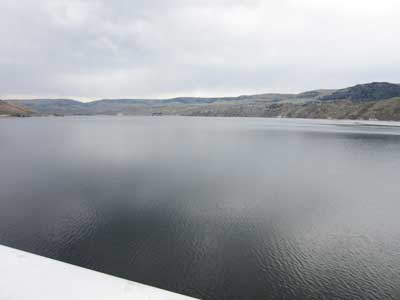DRIVE (Day 6)
I hit the road in the morning and headed west, enjoying the lovely country scenery.


Long Lake Dam, completed in 1915, is a concrete gravity dam about 30 miles northwest of Spokane. It has a hydroelectric generating capacity of 71 megawatts.


The Spokane River


Continuing through the state of Washington
I made a stop at Grand Coulee Dam. After looking around the visitor center, I headed over to the parking area where I took a free tour. It included a visit to the pump generators and then a bus ride across the top of the dam.


The real dam... and a model of it

Click for a larger view
Grand Coulee Dam is a gravity dam on the Columbia River, built to produce hydroelectric power, provide irrigation water and control floods. It was constructed between 1933 and 1942 with two powerhouses. A third powerhouse was completed in 1975 to increase energy production.
The dam is 1 mile long, contains almost 12 million cubic yards of concrete and weighs over 24 million tons.

The third power plant is the largest of the three powerhouses. During its construction from 1967 - 1975, a section of the existing dam had to be removed. The east end of the dam was blown off and the new power plant structure was attached.
The six generating units have a total capacity of 4,215 megawatts (just a wee bit more than the 71 megawatts of Long Lake Dam!). Just one of these generators can supply a city the size of Seattle with all its power needs for a year. The average power generation at Grand Coulee is 21 billion megawatt-hours per year.

The six generators inside
We hopped on a bus which let us get out on the top of the dam.


The top of the dam... and Lake Roosevelt, which extends 151 miles upstream to the Canadian border.


The third (larger on the left) and second powerhouses


The first powerhouse... and the John W. Keys III Pump-Generating Plant (completed in 1951)
Named after John W. Keys III (1941 - 2008), who was the director of the US Bureau of Reclamation from 2001 to 2006 and tragically killed in a plane crash, these 12 pumps actually lift water from the river uphill into Banks Lakes for storage. Six of the pumps can be reversed, releasing water back down during peak hours to generate needed electricity.


Looking over the dam... and down the Columbia River
I cross the border into Canada at Oroville. After being screened through customs, I entered the province of British Columbia and continued to Osoyoos, about 3 miles away. I was going to spend the next few days catching up with my friend Wendy and her husband Ric.

The border
The weather took a turn for the worse, so after a short stroll around town, we sat and enjoyed a lovely dinner with some wine on their covered back balcony.

Osoyoos Lake is situated on the Okanagan River, a tributary of the Columbia River.


The covered porch with its incredible view over their back garden and out to the lake
return • continue

